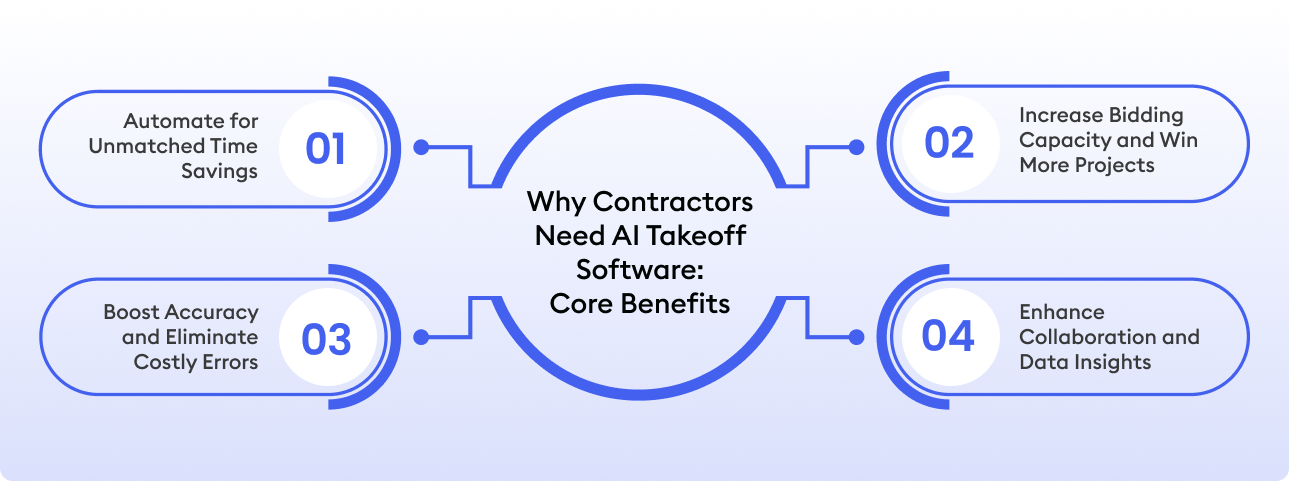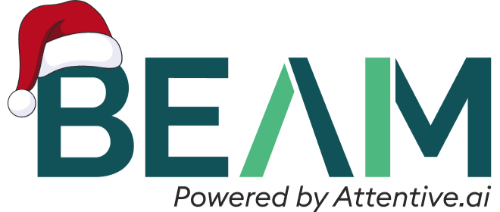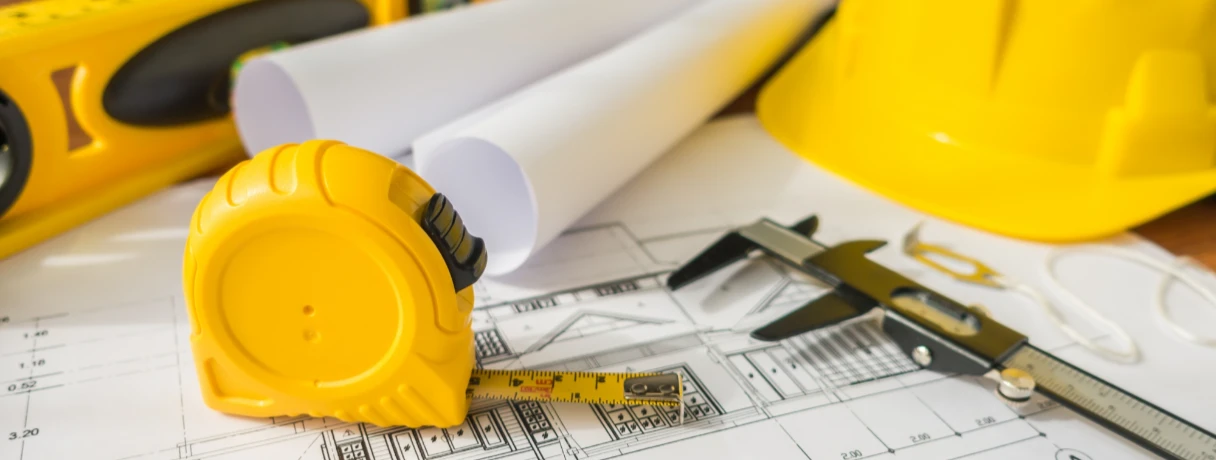Summary:
Long nights hunched over blueprints, spreadsheets stacked high, double-checking every pipe and conduit—this is the reality for many contractors during the preconstruction phase. Every minute spent on manual takeoffs is a minute not spent submitting bids, winning projects, or growing your business. You can’t scale a contracting business if your team spends most of its week on spreadsheets and manual measurements.
Bommarito Construction, a full-service site development and utility contractor, experienced this firsthand. Before adopting Beam AI, their team spent entire days on takeoffs for large projects, limiting how many bids they could submit. After integrating Beam AI, Bommarito Construction increased its bid volume by 50 projects in six months, driving approximately $1 million in additional revenue.
This real-world example highlights how AI takeoff software can transform estimating workflows, reduce errors, and unlock new opportunities. In this blog, we explore who can benefit most from AI takeoffs, the technologies behind them, and how contractors, subs, and suppliers can leverage solutions like Beam AI to save time, increase bids, and grow their business — read on to find out how.
Why Contractors Need AI Takeoff Software: Core Benefits

Automate for Unmatched Time Savings
One of the biggest advantages of using Beam AI is the significant time saved on takeoffs. Tasks that previously took 10 hours can now be completed in just 1–2 hours, with the AI handling the bulk of measurements and a quick review for accuracy.
This efficiency frees estimating teams to focus on higher-value work, such as refining project designs, negotiating with vendors, or preparing and submitting more bids — ultimately helping firms win more work without adding staff.
Boost Accuracy and Eliminate Costly Errors
Manual takeoffs are prone to human error — from miscounts to misinterpretation of plans, which can impact estimates and project costs. Beam AI addresses this by providing QA-reviewed outputs that maintain a high level of accuracy, typically within ±1% of in-house takeoffs.
The software also tracks plan revisions and addenda, automatically generating variance reports whenever new versions are uploaded. This ensures teams can update takeoffs quickly without redoing the entire takeoff, reducing errors and saving significant time on complex projects.
Increase Bidding Capacity and Win More Projects
In construction, time saved on takeoffs directly translates into more bids — and more opportunities to win work. That’s exactly what Beam AI helps contractors achieve.
A great example comes from Brady Roofing, a Salt Lake City–based contractor with over three decades of experience. Before using Beam AI, their team relied on manual takeoff tools like StackCT, spending nearly 10 hours each week on estimating alone. The challenge wasn’t finding projects — it was finding the time to bid on them.
After switching to Beam AI’s automated takeoff software, Brady Roofing’s estimating team saw a dramatic improvement. Their bid capacity increased by around 40%, allowing them to submit 3–4 additional bids every week, and the faster turnaround helped secure over $400,000 in additional projects.
Enhance Collaboration and Data Insights
Unlike traditional tools that trap information inside a single user’s spreadsheet, Beam AI centralizes all plans, takeoffs, and addendum versions on a unified cloud platform. This means estimators, project managers, and subcontractors are always looking at the same up-to-date quantities, eliminating the “version hell” that often happens when multiple spreadsheets circulate through email.
Beam AI also makes data export and integration effortless. Once a takeoff is complete, you can instantly export your results in Excel, PDF, or shareable link formats, depending on how your team prefers to review and estimate.
- Custom Excel Exports: Beam AI generates a structured, trade-organized Excel file ready to plug directly into your existing estimating workflow. Many general contractors use this alongside their preferred estimating or bidding software — keeping their pricing, labor, and markup processes intact while skipping the time-consuming takeoff work.
- Smart Organization: Each Excel sheet is structured by trade or category — like Demolition, Site Plan, Earthwork, or Utilities — and includes all line items, measured quantities (sqft, ft, count, cu yd), and even assembly-level breakdowns (e.g., sewer lines with fittings, collars, and manholes).
- Spec Auto-Detection and Quantity Tagging: Beam AI automatically detects specification details and applies quantity tags for materials, saving estimators from manual sorting and ensuring consistency when integrating with estimating software.
- Verification Made Easy: The exports include callout values and derived measurements, allowing teams to double-check quantities against plan notations — crucial for accuracy in bids and cost estimates.
- PDF and Screenshot Options: In addition to spreadsheets, users can export PDF reports and screenshots directly from Beam AI. These are perfect for internal reviews, client presentations, or sharing scope visuals with subcontractors.
This level of export flexibility means estimators receive a “plug-and-play” file: ready to layer in their own unit rates, labor costs, and markups without reformatting or re-entering data. The result is a streamlined workflow where digital takeoffs move seamlessly from measurement to bid-ready estimates.
Is AI Takeoff Software Right for Your Construction Business?
For General Contractors: Streamlining Project Bids
Problem: GCs manage multiple trades and rely on subcontractor estimates. Coordinating architectural, civil, structural, and MEP takeoffs is time-consuming, and inconsistencies across trades can delay bids or trigger errors. Updating estimates after plan revisions or addenda often requires rework across all trades.
How Beam AI Helps: Beam AI aggregates multi-trade takeoffs in one system, supporting PDFs from all major disciplines. Its plan variance reports let GCs quickly compare versions, stay responsive to addenda, and maintain consistency across trades—helping submit more accurate bids faster.
For Subcontractors: Precision for Specialty Trades
Problem: Trade contractors (electrical, plumbing, HVAC, concrete, etc.) face highly granular requirements. Even small errors—miscounted pipe lengths, missing fittings, or unmeasured duct transitions can lead to costly underbids or rework. Traditional takeoff tools aren’t built to automatically extract trade-specific details from complex plans.
How AI Helps: Beam AI reads detailed mechanical, electrical, plumbing, ductwork, piping, and structural elements automatically, including fixture counts, pipe lengths, and sheet areas. Subs reduce the risk of omissions or misestimates, improving bid accuracy and confidence on every project.
For Material Suppliers: Optimizing Material Lists & Procurement
Problem: Suppliers rely on accurate takeoffs to prepare quotes, plan stock requirements, and coordinate logistics. Manual estimates or inconsistent data from contractors often create miscommunication, over-ordering, or wasted materials.
How AI Helps: Beam AI delivers QA-reviewed, standardized takeoff outputs, enabling suppliers to receive precise material quantities directly from contractors. This reduces buffer margins, minimizes waste, and ensures procurement and delivery plans align with actual project needs. Being on the same digital workflow also strengthens collaboration and reduces errors caused by miscommunication.
Essential Features to Look for in AI Takeoff Solutions
Here’s what differentiates a good AI takeoff platform from a shelf product.
Automatic Element Detection & Classification
A key advantage of using Beam AI is its ability to automatically identify and quantify building elements—walls, doors, slabs, beams, fixtures, and more—directly from plans, without requiring manual tracing. This eliminates hours of repetitive, error-prone work, letting estimators focus on reviewing and refining results instead of drawing every line by hand.
Beam AI also understands trade boundaries, automatically classifying quantities by discipline — such as electrical, mechanical, plumbing, civil, or structural. This trade-specific organization ensures that takeoffs are immediately actionable for general contractors, specialty subcontractors, and suppliers alike.
For example, mechanical contractors can see precise pipe lengths, ductwork, and fittings; electrical teams can get accurate fixture counts; civil teams can review sitework quantities and assemblies. By providing structured, trade-wise outputs, Beam AI makes it easy to integrate takeoffs directly into estimating workflows, generate accurate bids faster, and reduce costly miscalculations across complex projects.
Cloud-Based Collaboration & Accessibility
Beam AI’s cloud-based platform ensures that everyone on the project team — whether in the office or on-site — is working from the same up-to-date takeoff data. Plans, takeoffs, and addendum versions are centralized, eliminating the confusion of multiple spreadsheets and outdated PDFs circulating via email.
With Beam AI, teams can upload new plans, review takeoffs, and export results from anywhere, on any device with internet access. Project managers can instantly verify quantities, estimators can check measurements, and subcontractors can access trade-specific details — all without waiting for files to be shared manually.
The platform also supports real-time collaboration, so changes and updates are immediately reflected for the entire team.
Reporting, Analytics & Predictive Capabilities
Beam AI goes beyond delivering accurate quantities — it provides tools to analyze data, track bids, and improve estimating efficiency. The platform’s Bid Dashboard allows contractors to manage every aspect of the bidding process in one place. Users can track deadlines, monitor bid statuses, compare estimates across projects, and quickly see which opportunities require attention, helping teams stay organized and responsive even on large, multi-trade projects.
A standout feature is BeamGPT, an AI-powered estimator assistant built into the platform. BeamGPT can “chat with your plans,” meaning it can interpret specifications, cross-reference notes across multiple sheets, and summarize key details in seconds. For example, it can quickly identify all required ductwork fittings, highlight revisions from addenda, or pull quantities for a specific trade — tasks that would normally take hours.
Combined, the Bid Dashboard and BeamGPT turn raw takeoff data into actionable insights, allowing teams to make informed decisions faster, reduce errors, and focus on high-value estimating tasks rather than manual data crunching..
Putting It All Together
If your construction or contracting business faces bottlenecks in estimating — slow manual takeoffs, errors, limited bid capacity — AI takeoff software is not just a trend, but a strategic leap.
Beam AI helps save 90% time that was earlier spent on doing takeoffs, gives you QA-reviewed outputs, provides multi-trade support, and bid management features especially for GCs, subcontractors, and suppliers. Book a demo to know more about Beam AI.
FAQs
1. Who can benefit from AI takeoff software?
Contractors, subcontractors, and suppliers can all benefit. GCs streamline multi-trade bids, subs get precise trade-specific quantities, and suppliers optimize procurement.
2. Can AI handle multi-trade projects?
Yes. AI takeoff software supports architectural, structural, civil, MEP, and specialty trades, providing structured outputs for each discipline.
3. Does AI takeoff software improve collaboration?
Yes. Cloud-based platforms centralize all plans and takeoffs, ensuring all team members work from the same up-to-date data
4. How does AI takeoff software help win more projects?
By saving time and increasing bid capacity, contractors can submit more bids with faster turnaround, improving chances of winning work.








.webp)



.webp)

